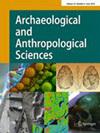The third dimension of stone points: 2D vs. 3D geometric morphometric shape analysis
Abstract
Only recently has the use of 3D-scanning technology enhanced our ability to consider shape using landmark approaches to geometric morphometrics (GM). Studies examining several types of anthropological datasets have provided mixed reviews of the utility of the third dimension in landmark GM shape analyses. In this paper we present the results of a study examining the methodological utility of three dimensions in landmark GM shape analysis of prehistoric stone points. We used GM to generate principal components (PCs) of shape variation from independent data sets of Clovis and Dalton points in different shape spaces using 2D and 3D versions of the same sample and examined variation in the distribution of shape variables on PCs generated for each data set. Results of uniform multivariate statistical tests performed on each dataset’s PCs were compared to observe whether 2D or 3D data is more effective at determining group membership. We then generated PCs of shape variation in the same shape space using dependent 2D and 3D datasets to observe whether 2D versions of the data cluster with corresponding 3D versions of each point in a PC biplot and multivariate cluster analysis. Results suggest that 2D GM analysis is as capable of discriminating between Clovis and Dalton points as analyses conducted with 3D data. However, those interested in manufacturing technology will benefit from information provided by 3D data sets, which can capture information such as original blank form and thinning strategies.


 求助内容:
求助内容: 应助结果提醒方式:
应助结果提醒方式:


